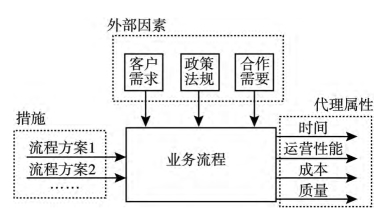如同处理变更一样,限制变更所带来的影响也是无法直接测量的。限制变更所带来的影响通常涉及对系统复杂度的控制。Simon是该观点的奠基人,他认为一个复杂系统由相互区分又互相作用的不同部分组成[40]。系统的这一特性可以被称为模块性。模块性是一个普遍的系统概念,用于描述“一个系统的不同组件之间可以相互分离或者组合的程度”[41]。当业务流程变更发生时,模块通过提供可管理的程序单元和易于建立或者销毁某个模块的能力从而提升柔性。模块还能通过减少对子单元之间进行协调的需求从而提高处理变更的速度。然而,当某个流程当前的模块性程度不足时,可能会出现无法处理不可预见的变更的情况。此外,根据Terlouw的研究,目前尚未见文献中提到有清晰测量(软件)系统模块性的指标[42]。关于复杂度和模块化的观点我们将在第3章详细讨论。
观测业务流程柔性需要对影响业务流程柔性的因素有充分的认识。定性研究指出时间、性能、成本和质量可以作为测量柔性的代理属性[43][44]。而进一步对这些属性进行可量化的操作则往往与具体的流程工作环境相关。
以电子政务中典型的业务流程为例,影响该业务流程的环境因素通常有客户(市民)的需求,相关政策法规的规定,以及部门内部或者部门间相互合作的需要。如果我们把该业务流程看做一个黑盒的话,上文提到的4个代理属性可以帮助我们用来衡量业务流程柔性的水平,即时间、运营性能、成本和质量。这种测量通常可以做到与具体的实现技术无关。因此,通过比较这些代理属性的测量值,我们可以比较不同流程方案所提供的流程柔性的水平是否有所差异,如图2-2所示。
该模型可以帮助我们构造研究实验,从而比较不同流程方案的柔性水平。在比较的过程中,需要屏蔽外部因素的影响,即在同一外部环境中进行比较。在实际操作中,为了结果清晰可见,通常只会针对其中一个代理属性进行比较。由于研究的思路是相通的,同样的方法可以使用在更加复杂的情况下或者更多方案的情况下。

图2-2 测量业务流程柔性的概念化模型
【注释】
[1]Gong Y,Janssen M.From Policy Implementation to Business Process Management:Principles for Creating Flexibility and Agility[J].Government Information Quarterly,2012,29(1):61-71.
[2]Patiniotakis I,Papageorgiou N,Apostolou D,et al.Collaborative Process Flexibility Using Multi-Criteria Decision Making[M]//Camarinha-Matos L M,Scherer R J.Collaborative Systems for Reindustrialization.Heidelberg:Springer,2013:691-698.
[3]Schonenberg H,Mans R,Russell N,et al.Process Flexibility:A Survey of Contemporary Approaches[M]//Dietz J L G,Albani A,Barjis J.Advances in Enterprise Engineering I.Heidelberg:Springer,2008:16-30.
[4]Schonenberg H,Mans R,Russell N,et al.Process Flexibility:A Survey of Contemporary Approaches[M]//Dietz J L G,Albani A,Barjis J.Advances in Enterprise Engineering I.Heidelberg:Springer,2008:16-30.
[5]Mechrez I,Reinhartz-Berger I.Modeling Design-Time Variability in Business Processes:Existing Support and Deficiencies[M]//Bider I,Gaaloul K,Krogstie J,et al.Enterprise,Business-Process and Information Systems Modeling.Heidelberg:Springer,2014:378-392.
[6]Alter M J.Science of flexibility[M].Human Kinetics,2004.
[7]Van Den Bosch F A J,Volberda H W,Boer M D.Coevolution of Firm Absorptive Capacity and Knowledge Environment:Organizational Forms and Combinative Capabilities[J].Organization Science,1999,10(5):551-568.
[8]Bernardes E S,Hanna M D.A Theoretical Review of Flexibility,Agility and Responsiveness in the Operations Management Literature[J].International Journal of Operations&Production Management,2009,29(1):30-53.
[9]Stevenson M,Spring M.Flexibility from a Supply Chain Perspective:Definition and Review[J].International Journal of Operations&Production Management,2007,27(7):685-713.
[10]Das A.Towards Theory Building in Manufacturing Flexibility[J].International Journal of Production Research,2001,39(18):4153-4177.
[11]Shi D,Daniels R L.A Survey of Manufacturing Flexibility:Implications for E-Business Flexibility[J].IBM Systems Journal,2003,42(3):414-427.
[12]Soffer P.On the Notion of Flexibility in Business Processes[C].CAiSE'05 Workshop,2005:35-42.
[13]Heinl P,Horn S,Jablonski S,et al.A Comprehensive Approach to Flexibility in Workflow Management Systems[C].The International Joint Conference on Work Activities Coordination and Collaboration,1999:79-88.
[14]Regev G,Wegmann A.A Regulation-Based View on Business Process and Supporting System Flexibility[C].Workshop on Business Process Modeling,Design and Support(BPMDS 2005),CAiSE 2005 Workshops,2005:35-42.
[15]Heinl P,Horn S,Jablonski S,et al.A Comprehensive Approach to Flexibility in Workflow Management Systems[C].The International Joint Conference on Work Activities Coordination and Collaboration,1999:79-88.
[16]Heinl P,Horn S,Jablonski S,et al.A Comprehensive Approach to Flexibility in Workflow Management Systems[C].The International Joint Conference on Work Activities Coordination and Collaboration,1999:79-88.
[17]Schonenberg H,Mans R,Russell N,et al.Process Flexibility:A Survey of Contemporary Approaches[M]//Dietz J L G,Albani A,Barjis J.Advances in Enterprise Engineering I.Heidelberg:Springer,2008:16-30.
[18]Nurcan S.A Survey on the Flexibility Requirements Related to Business Processes and Modeling Artifacts[C].41st Hawaii International Conference on System Sciences,2008.
[19]Regev G,Wegmann A.A Regulation-Based View on Business Process and Supporting System Flexibility[C].Workshop on Business Process Modeling,Design and Support(BPMDS 2005),CAiSE 2005 Workshops,2005:35-42.(https://www.daowen.com)
[20]Soffer P.On the Notion of Flexibility in Business Processes[C].CAiSE'05 Workshop,2005:35-42.
[21]Schonenberg H,Mans R,Russell N,et al.Process Flexibility:A Survey of Contemporary Approaches[M]//Dietz J L G,Albani A,Barjis J.Advances in Enterprise Engineering I.Heidelberg:Springer,2008:16-30.
[22]Cognini R,Corradini F,Gnesi S,et al.Business Process Flexibility-A Systematic Literature Review with a Software Systems Perspective[J].Information Systems Frontiers,2018,20(2):343-371.
[23]Brand N,Van Der Kolk H.Workflow Analysis and Design[M].Deventer:Kluwer Bedrijfswetenschappen,1995.
[24]Reijers H A,Mansar S L.Best Practices in Business Process Redesign:An Overview and Qualitative Evaluation of Successful Redesign Heuristics[J].Omega,2005,33(4):283-306.
[25]Reijers H A,Mansar S L.Best Practices in Business Process Redesign:An Overview and Qualitative Evaluation of Successful Redesign Heuristics[J].Omega,2005,33(4):283-306.
[26]Nelson K M,Nelson H J,Ghods M.Technology Flexibility:Conceptualization,Validation,and Measurement[C].30th Hawaii International Conference on System Sciences(HICSS),1997.
[27]Harrington H J.Business Process Improvement:The Breakthrough Strategy for Total Quality,Productivity,and Competitiveness[M].New York:McGraw-Hill,1991.
[28]Nelson K M,Nelson H J,Ghods M.Technology Flexibility:Conceptualization,Validation,and Measurement[C].30th Hawaii International Conference on System Sciences(HICSS),1997.
[29]Wadhwa S,Rao K S.Flexibility and Agility for Enterprise Synchronization:Knowledge and Innovation Management towards Flexagility[J].Studies in Information and Control,2003,12(2):111-128.
[30]Regev G,Soffer P,Schmidt R.Taxonomy of Flexibility in Business Processes[C].The 7th Workshop on Business Process Modelling,Development and Support(BPMDS'06),CAiSE Workshop,2006:90-93.?
[31]Nelson K M,Nelson H J,Ghods M.Technology Flexibility:Conceptualization,Validation,and Measurement[C].30th Hawaii International Conference on System Sciences(HICSS),1997.
[32]Wadhwa S,Rao K S.Flexibility and Agility for Enterprise Synchronization:Knowledge and Innovation Management towards Flexagility[J].Studies in Information and Control,2003,12(2):111-128.
[33]Moitra D,Ganesh J.Web Services and Flexible Business Processes:Towards the Adaptive Enterprise[J].Information&Management,2005,42(7):921-933.
[34]Gebauer J,Schober F.Information System Flexibility and the Cost Efficiency of Business Process[J].Journal of the Association for Information Systems,2006,7(3):122-147.
[35]关于知识密集型流程和知识密集型服务业,请参考本书第4章的内容。
[36]Kumar V,Smart P A,Maddern H,et al.Alternative Perspectives on Service Quality and Customer Satisfaction:The Role of BPM[J].International Journal of Service Industry Management,2008,19(2):176-187.
[37]Glinz M.On Non-Functional Requirements[C].15th IEEE International Requirements Engineering Conference,Delhi,2007:21-26.
[38]Gross D,Yu E.From Non-Functional Requirements to Design through Patterns[J].Requirements Engineering,2001,6(1):18-36.
[39]Jansen-Vullers M H,Kleingeld P A M,Loosschilder M W N C,et al.Trade-Offs in the Performance of Workflows-Quantifying the Impact of Best Practices[M]//Business Process Management Workshops.Heidelberg:Springer,2008.
[40]Simon H A.The Sciences of the Artificial[M].3rd ed.Cambridge,Massachusetts:MIT Press,1996.
[41]Schilling M A.Toward a General Modular Systems Theory and Its Application to Interfirm Product Modularity[J].Academy of Management Review,2000,25(2):312-334.
[42]Terlouw L.Modularization and Specification of Service-Oriented Systems[D].Delft:Delft University of Technology,2011.
[43]Reijers H A,Mansar S L.Best Practices in Business Process Redesign:An Overview and Qualitative Evaluation of Successful Redesign Heuristics[J].Omega,2005,33(4):283-306.
[44]Vanderfeesten I,Reijers H A,Van Der Aalst W M P.Evaluating Workflow Process Designs Using Cohesion and Coupling Metrics[J].Computers in Industry,2008,59(5):420-437.
免责声明:以上内容源自网络,版权归原作者所有,如有侵犯您的原创版权请告知,我们将尽快删除相关内容。






